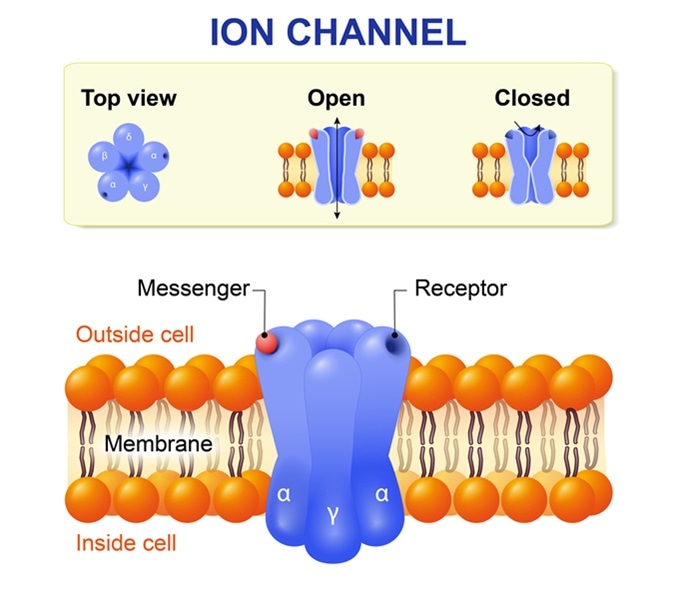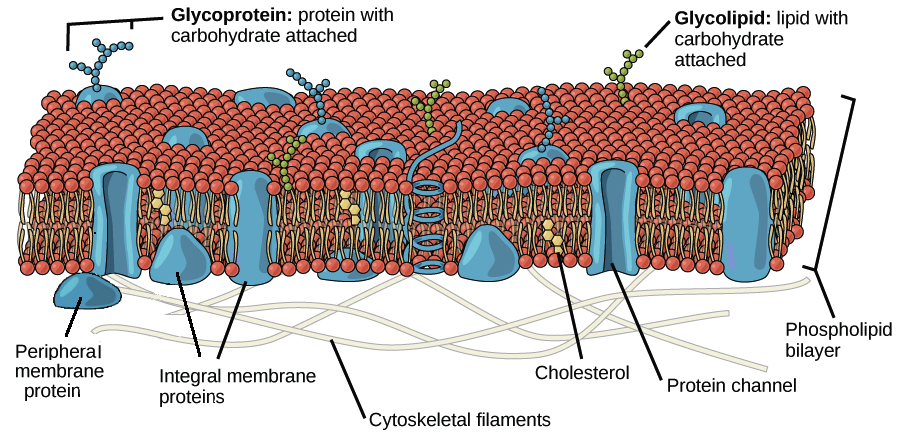One class of channel proteins found in virtually all animals forms gap junctions between two adjacent cells. It is semi-permeable and regulates the materials that.

Plasma Membrane Markers Novus Biologicals
In neurons chemically gated ion channels are found on dendrites and the cell body.

. Modification of work by Randy LeMoine Chapter Outline. The plasma membrane is an extremely pliable structure composed of 2 layers of back-to-back phospholipids a bilayer. Proteins which form channels may be utilized.
Distribution of membrane channels is different between areas of the plasma membrane affecting cell responses to stimuli and the parts of the cell that are involved. Channel proteins can aid in the facilitated diffusion of substances by forming a hydrophilic passage through the plasma membrane through which polar and charged substances can pass. The best-characterized channel proteins however are the ion channels which mediate the passage of ions across plasma membranes.
Channel proteins can aid in the facilitated diffusion of substances by forming a hydrophilic passage through the plasma membrane through which polar and charged substances can pass. The plasma membrane is selectively permeable. Integral membrane proteins that form channels across.
It is also simply called the cell membrane. Along axons are voltage-gated sodium and potassium ion channels. Especially important in intercellular communication.
81 Membrane Components and Structure. These channels are discussed in Chapter 19 and will not be considered further here. Analogously a plasma membranes functions involve movement within the cell and across boundaries in the process of intracellular and intercellular activities.
Each plasma membranecontributes equally to the formation of the channel which connects the cytoplasmof the two cells. Bind cells together and function as anchors for fibers in the cytoskeleton. Small channels that form across plasma membranes of adjacent cells important in intercellular communication.
Small channels that form across the plasma membranes of adjacent animal cells especially important in intercellular communication help coordinate activities of adjacent cells. Important in intercellular communication found in animals Desmosomes membrane protein complexes that strengthen the adhesion between adjacent cells like rivets to protect against pulling forces found in animals. Cholesterol is also present between the phospholipids which contributes to the fluidity of the membrane.
Click to see full answer. The pores formed by these channel proteins are not permanently open. A group of transmembrane ion-channel proteins.
Channel proteins can be open at all times constantly allowing a particular substance into or out of the cell depending on the concentration gradient. A single phospholipid molecule has a phosphate. Furthermore what kind of molecule forms a channel through the membrane.
Once open channel proteins form small pores through which ions of the appropriate size and charge can cross the membrane by free diffusion. Membrane proteins that create a watertight seal between animal cells to connect them and to keep fluid from crossing barriers. Microbe-synthesized ionophores such as valinomycin facilitate the diffusion of ions across the cell membrane by complexing and shuttling ions.
Although ion channels are present in the membranes of all cells they have been especially well studied in nerve and muscle where their regulated opening and closing is responsible for the transmission of electric signals. Small molecules are also often transported. The plasma membrane of a cell is a network of lipids and proteins that forms the boundary between a cells contents and the outside of the cell.
Or they can be gated and can only be. Substance moves from an area of high concentration to an area of low concentration. Ion channels for example allow the passage of inorganic ions such as Na K Ca2 and Cl- across the plasma membrane.
Both gap junctions and porins the channel-forming proteins of the. There are various proteins embedded within the membrane that have a variety of functions. Rather they can be selectively opened and.
The main function of the plasma membrane is to protect the cell from its surrounding environment. Water is transported across the membrane by the aquaporin AQP family of passive channels. Channel proteins that allow water to cross the membrane very quickly.
- integral membrane proteins that form channels across the membrane through which certain substances can pass o Carrier proteins-bind substances and speed up their diffusion through the bilayer Facilitated diffusion- subs diffuse according to concentration grad but with channel or carrier ION CHANNELS o Gated. Small channels that form across the plasma membrane of adjacent cells. Especially important in intercellular communication.
Small channels that form across the plasma membranes of adjacent animal cells. Membrane protein complexes that strengthen the adhesion between adjacent animal cells like rivets to protect against pulling forces. Or they can be gated and can only be.
Channel proteins can be open at all times constantly allowing a particular substance into or out of the cell depending on the concentration gradient. Help coordinate activities of adjacent cells. Integral membrane proteins enable ions and large polar molecules to pass through the membrane by passive or active transport.
By forming a continuous protein pathway across the membrane these proteins enable specific hydrophilic solutes to cross the. Hydrophobic molecules and small polar molecules can diffuse through the lipid layer but ions and large polar molecules cannot. Span the membrane and make hydrophilic tunnels across it allowing molecules to move through by diffusion.
Ion channels for example allow the passage of inorganic ions such as Na K Ca 2 and Cl-across the plasma membrane. Aid in coordination of activities between cells. Small channels that form across the plasma membranes of adjacent animal cells.
Membrane proteins that create a watertight seal between cells. Barrier that prevents fluids from moving between cells. Other ionophores such as gramicidin A form channels.

Types Of Ion Channels In The Body

Structure Of The Plasma Membrane Article Khan Academy
0 Comments